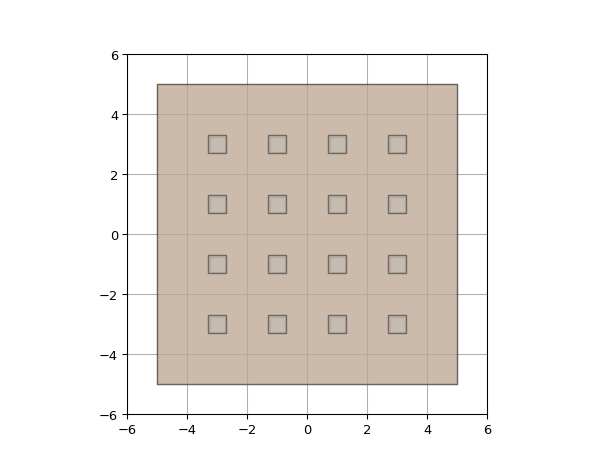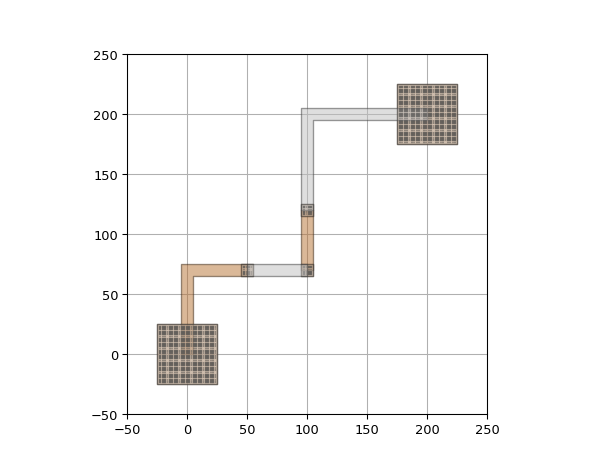VIA
- class ipkiss3.all.VIA
Place a via and change trace template at a certain point along the route.
- Parameters:
- xy: Sequence, XYSymbol
XY-coordinate through which the route should go.
- direction_in: DIRECTION
Direction from which the route comes into the control point (i3.NORTH, i3.EAST, i3.SOUTH, i3.WEST). If not specified, the routing algorithms will use heuristics to provide a guess.
- direction_out: DIRECTION
Direction at which the route goes out of the control point (i3.NORTH, i3.EAST, i3.SOUTH, i3.WEST). If not specified, the routing algorithms will use heuristics to provide a guess.
- trace_template: TraceTemplate, None
New trace template to use, starting from the current control point.
- layout: PCell, LayoutView, _Element, Sequence[_Element], None
Via (reference) elements or PCell to insert at the control point’s location.
- relative_to: str, Sequence, None
Reference to an instance, port, or a coordinate, relative to which this control point is defined. This cannot be combined with a symbolic xy. See Symbols for more information.
Examples
First to define VIA_M1_M2_ARRAY which is used for layout property of i3.VIA
import si_fab.all as pdk import ipkiss3.all as i3 class VIA_M1_M2_ARRAY(i3.PCell): box_size = i3.Size2Property(default=(10, 10)) via_pitch = i3.Size2Property( default=i3.TECH.BONDPAD.VIA_PITCH, doc="2D pitch (center-to-center) of the vias" ) via = i3.ChildCellProperty(doc="Via used") def _default_via(self): return pdk.VIA_M1_M2() class Layout(i3.LayoutView): def generate(self, layout): layout += i3.Rectangle(layer=i3.TECH.PPLAYER.M1, box_size=self.box_size) layout += i3.Rectangle(layer=i3.TECH.PPLAYER.M2, box_size=self.box_size) periods_x = int(self.box_size[0] / self.via_pitch[0]) - 1 periods_y = int(self.box_size[1] / self.via_pitch[1]) - 1 layout += i3.ARef( reference=self.via, origin=( -(periods_x - 1) * self.via_pitch[0] / 2.0, -(periods_y - 1) * self.via_pitch[1] / 2.0, ), period=self.via_pitch, n_o_periods=(periods_x, periods_y), ) return layout VIA_M1_M2_ARRAY().Layout().visualize()

# define direction_in and direction_out of VIA bp = pdk.BondPad() via_array = VIA_M1_M2_ARRAY() tt_m2 = pdk.M2WireTemplate() circuit = i3.Circuit( insts={"pad1": bp, "pad2": bp}, specs=[ i3.Place("pad1", (0, 0)), i3.Place("pad2", (200, 200)), i3.ConnectElectrical( "pad1:m1", "pad2:m2", start_angle=45, start_straight=50, end_angle=180, control_points=[ i3.VIA( (100, 100), direction_in=i3.SOUTH, direction_out=i3.NORTH, trace_template=tt_m2, layout=via_array, ), ], ), ], ) circuit.get_default_view(i3.LayoutView).visualize()

bp = pdk.BondPad() via_array = VIA_M1_M2_ARRAY() M1_wire_tpl = pdk.M1WireTemplate().Layout(width=10) M2_wire_tpl = pdk.M2WireTemplate().Layout(width=10) circuit = i3.Circuit( insts={"pad1": bp, "pad2": bp}, specs=[ i3.Place("pad1", (0, 0)), i3.Place("pad2", (200, 200)), i3.ConnectElectrical( "pad1:m1", "pad2:m2", start_angle=45, start_straight=50, end_angle=180, trace_template=M1_wire_tpl, # Override start trace template control_points=[ i3.VIA( (100, 100), direction_in=i3.SOUTH, direction_out=i3.NORTH, trace_template=M2_wire_tpl, # Set end trace template layout=via_array, ), ], ), ], ) circuit.get_default_view(i3.LayoutView).visualize()

# Use multiple vias in Electrical route bp = pdk.BondPad() via_array = VIA_M1_M2_ARRAY() M1_wire_tpl = pdk.M1WireTemplate().Layout(width=10) M2_wire_tpl = pdk.M2WireTemplate().Layout(width=10) circuit = i3.Circuit( insts={"pad1": bp, "pad2": bp}, specs=[ i3.Place("pad1", (0, 0)), i3.Place("pad2", (200, 200)), i3.ConnectElectrical( "pad1:m1", "pad2:m2", start_angle=90, end_angle=180, trace_template=M1_wire_tpl, control_points=[ i3.VIA( (50, 70), direction_in=i3.WEST, direction_out=i3.EAST, trace_template=M2_wire_tpl, layout=via_array, ), i3.VIA( (100, 70), direction_in=i3.WEST, direction_out=i3.NORTH, trace_template=M1_wire_tpl, layout=via_array, ), i3.VIA( (100, 120), direction_in=i3.SOUTH, direction_out=i3.NORTH, trace_template=M2_wire_tpl, layout=via_array, ), ], ), ], ) circuit.get_default_view(i3.LayoutView).visualize()
